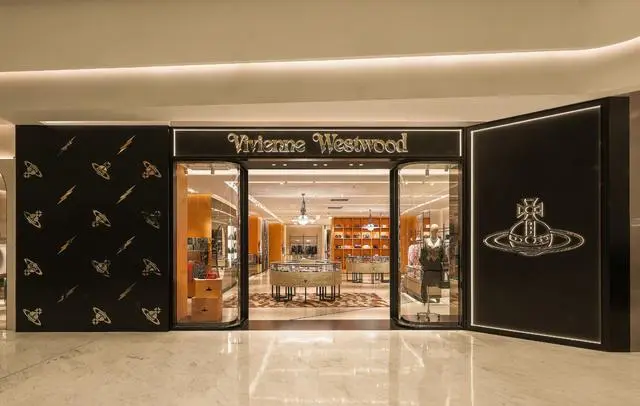British designer brand Vivienne Westwood has recently opened a store in the central area of Hangzhou. This marks its first store in Hangzhou, featuring street-front placement and a two-story retail space. Located above the Wulin Square subway station, Hangzhou Center is another key investment project by China Resources in the city.
Accompanied by office spaces and a Four Seasons hotel, many netizens believe that a brand with a double-story store in a commercial project below could be on par with Louis Vuitton and Dior. However, Vivienne Westwood has given ample attention to this store, and besides the two-story space, there may also be a coffee shop inside.
Although designer Vivienne Westwood passed away in December 2022, the brand’s expansion has not been affected. Recently, it also opened a double-story store in Sanlitun, Beijing, and in the past year, it has opened stores in cities including Chengdu, Hefei, Shenzhen, Wuhan, and Tianjin. Earlier, it had already opened stores in Xintiandi Taifu Plaza on Nanjing West Road in Shanghai and Huamao Commercial Street across from SKP in Beijing.
As Vivienne Westwood is not a publicly traded company, it is not obligated to regularly disclose financial data to the public. However, according to documents submitted to the UK Companies Registry, its revenue increased by 57% year-on-year in 2021, with a gross profit growth of 81%, reaching £66.2 million and £40.3 million, respectively. It remains a relatively small company.
In comparison, Acne Studios, with a similar price range, achieved sales of €260 million in 2020, but it has only 18 stores in mainland China. According to Vivienne Westwood’s official WeChat account, it currently has a total of 25 stores in China. Vivienne Westwood entered mainland China in 2011, while Acne Studios entered in 2018.
Similar to most European designer brands, Vivienne Westwood initially engaged with Chinese consumers through Hong Kong and mainland channels. An article from Women’s Wear Daily in 2011 noted that around 60% of sales in all Hong Kong stores were contributed by mainland consumers. In the same year, Vivienne Westwood opened its first store in mainland China at Shanghai’s Ganghui Henglong Plaza.
However, Vivienne Westwood herself did not express much enthusiasm for expanding in the Chinese market, stating directly, “I don’t know much about the Chinese market, and I’m not very interested in developing in this market.” But the designer’s statement is one thing, and the actual thoughts of the management are another.
Due to the scale, European designer brands typically start their expansion in the Chinese market from concept stores. However, after formally entering the mainland market, Vivienne Westwood opened many stores, thanks to its collaboration with Shandong Ginza Commercial Group, establishing a joint venture. Vivienne Westwood is responsible for providing style, while Ginza Commercial Group offers retail spaces through its nationwide business resources.
For Chinese consumers, Ginza Commercial Group is most known for its mall brand Ginza Shopping Mall, primarily operating in the North China market. In terms of levels, the projects of Ginza Commercial Group include malls reaching county towns and high-end shopping centers in provincial capitals.
From various opening announcements, it can be seen that in 2013, Vivienne Westwood opened a store in Jinan Ginza Shopping Mall, followed by entries into Wanda Plaza in Wuhan, Babel Bazaar in Wuxi, Greenland Colorful City in Nanchang, Maoye Tiandi in Chongqing, and Heshenghui in Wujiaochang, among other malls. Most of these malls have good foot traffic, but compared to Shenzhen MixC World, Sanlitun Taikoo Li, and Shanghai Xintiandi Taifu, there is a significant gap in level.
This has, to some extent, led to Vivienne Westwood having a recognizable but not highly elevated presence in the Chinese market—a situation where it expands but lacks visibility. However, on the other hand, due to its overall limited scale and limited marketing initiatives in the Chinese market, this provides space for adjustment in its future development strategy.
In recent years, Vivienne Westwood has re-embraced its positioning as a high-end designer brand in China. It continually emphasizes the founder’s avant-garde image and design heritage, gaining recognition on social media, particularly among those who identify with its aesthetics through Japanese anime such as “Nana.” These efforts have rekindled a sense of freshness in the market for this brand that entered China early.
However, the Chinese market is not short of European designer brands. Vivienne Westwood’s advantage lies in its existing entry-level popular products, such as the Saturn Logo necklace. On the other hand, its more comprehensive punk image is still not fully recognized by consumers in China and is mostly praised within the fashion enthusiast community.
Compared to accessories such as handbags and shoes, products like necklaces and bracelets have high substitutability, and brands find it challenging to command premium pricing in this category. Given the current scale of store openings and speed, the overall image effect brought by Vivienne Westwood’s product portfolio still needs improvement.
Nevertheless, it is still on the radar of real estate developers. Many shopping centers have recently initiated adjustments. After the heat of the previous streetwear trend, these developers are now focusing on introducing designer brands as a complement to other high-end luxury brands. Taking advantage of these store-opening opportunities, Vivienne Westwood is reviving its high-end image.
More importantly, changes in the retail environment have led many luxury brands to adjust their expansion strategies. Many newly built malls, originally intended for high luxury positioning, have had to choose high-end designer brands as substitutes. This phenomenon was frequent during the cold winter period of the luxury goods industry around 2015. Although many designer brands are later required to relocate within malls after the industry rebounds, they are still sought after as a supplement to luxury brands.
